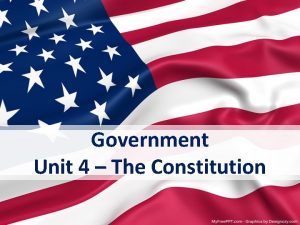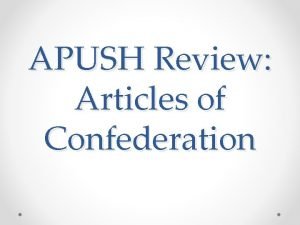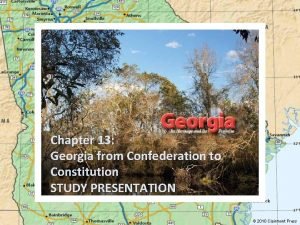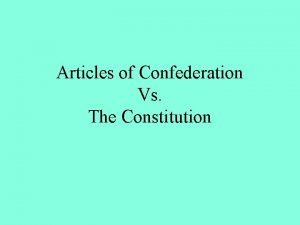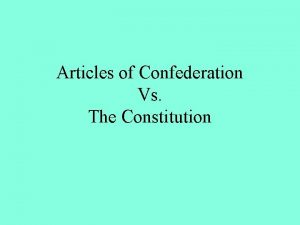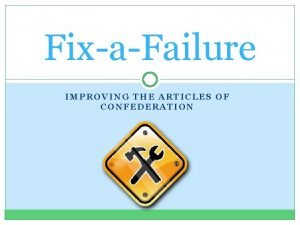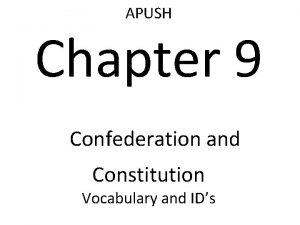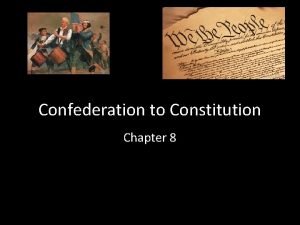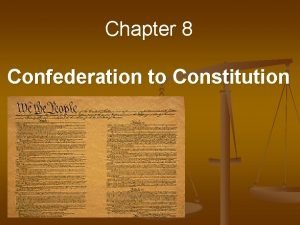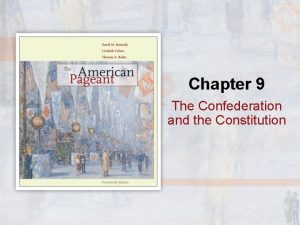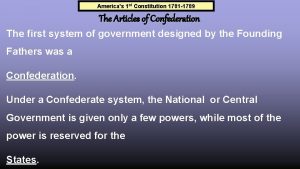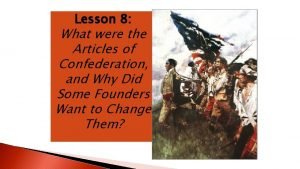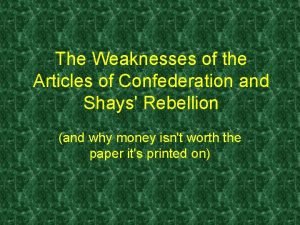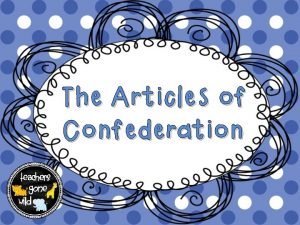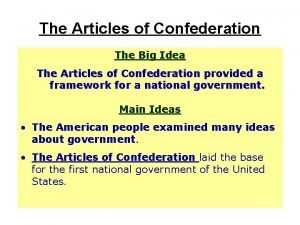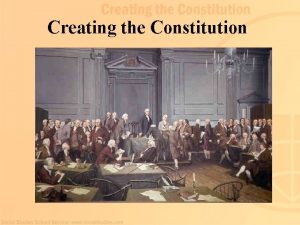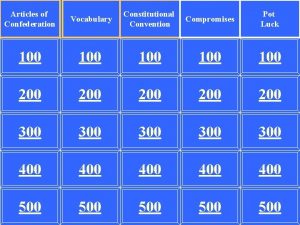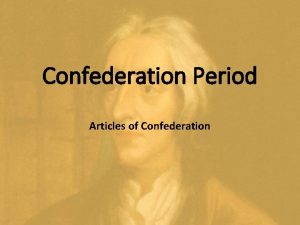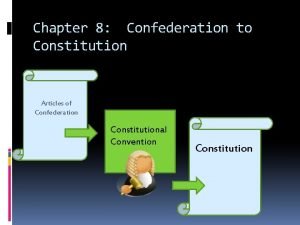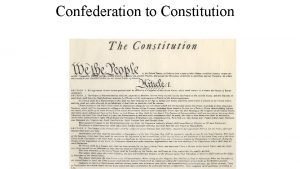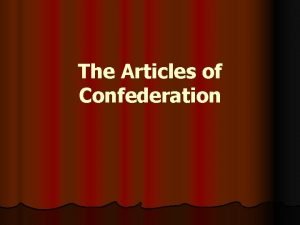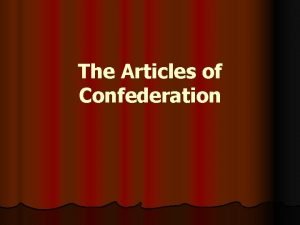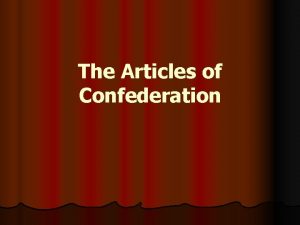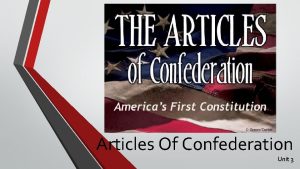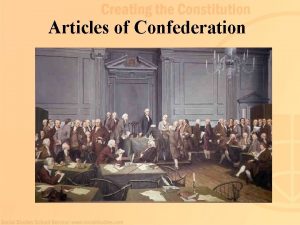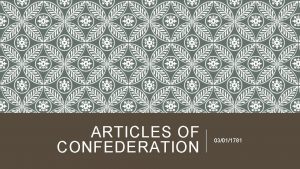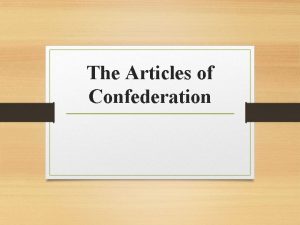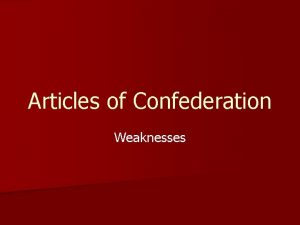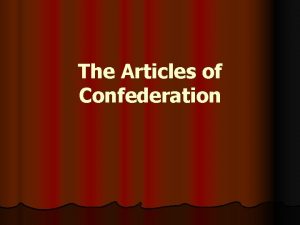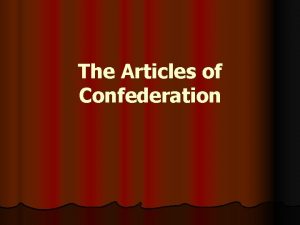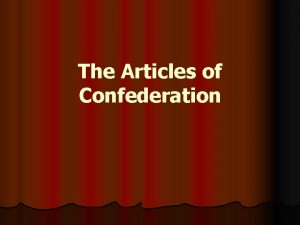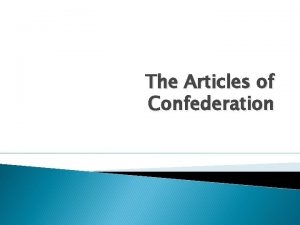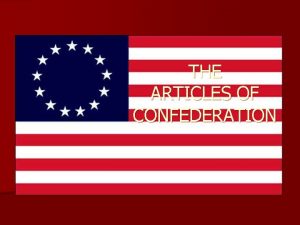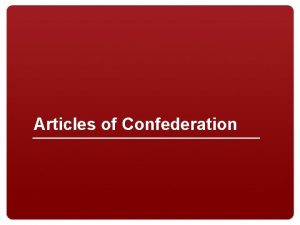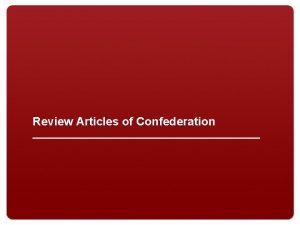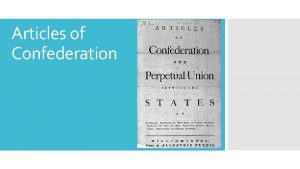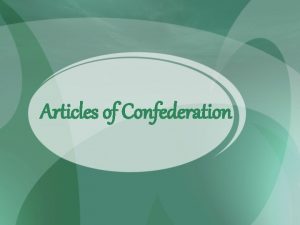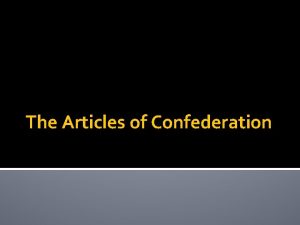Articles of ConfederationU S Constitution Articles of Confederation






















- Slides: 22

Articles of Confederation/U. S. Constitution

Articles of Confederation • ______– rules and laws that form a government • _____– 2 nd Continental Congress – began work on creating government • Were influenced by English Law –_______ – and _______ • ________– citizens elect ________responsible to the _____ • ___________– even ____had to obey the law, no one has total power • _____– Right to _____– taxpaying or propertyowning white _____ • ______________– America’s first ______(plan of government) – Committee of ___

• National government would be a _____ • States would join in a ______– loose union – states would have more ______than national govt. • A. All states had to _______(approve) before it became ______ • B. __out of ___states had to agree on new laws or major decisions • C. All 13 states had to agree to ____(change or add) the articles • D. Only _______had the power to tax and enforce law • E. No real ____– 3 person committee chosen by Congress – very limited powers

• F. _______(one house) legislature – each state had ____vote • G. No system of national ____ H. Weaknesses – no____, could not regulate_______, national congress responsible to the state _______– not the ____ • I. Powers of national government – could make and borrow______, foreign ____(wage war, make peace), _______affairs • J. Articles are not ____until March of ______– disputes over land claims • Land ______of _____/Northwest ______of ______– created a system for bringing new states into the country – had to have a population of 60, 000

Problems in the New Nation • 1. National government could do little to enforce laws or protect citizens • 2. _______problems • A. ____– taxes on imported and exported goods • B. _____was forcing U. S. to pay high tariffs on goods sold in Britain • C. Britain closed many ______to Americans and forced them to use British ______ • D. Confederation Congress could not pass _____to punish Britain

• 3. Congress could not regulate_________ • 4. Each state printed its own ____– many began printing large amounts of ______money to pay off war debts • 5. _____– increased prices on goods and services – reduced value of money • 6. ______– period of low economic activity and high unemployment • 7. ______– people who owe money or taxes • 8. ______– people who lend money • 9. ____Rebellion – September 1786 • 10. Many people in the states saw that the Articles were not working • New Constitutional _______would be held in _______in May of 1787

Constitutional Convention • 1. Philadelphia Convention • A. Date – May_______ • B. Purpose – To discuss ______issues and _______Articles of Confederation – James_____, Alexander ______ • C. Plan –____Articles to give national government increased _____to solve nation’s problems • D. Decision – create a new plan of government (Constitution)

Virginia Plan – written mostly by Madison – Large-state plan • A. _______Branches of government • 1. ______–_____the laws – Two-house (_________) legislature • 2. ______– carries out and _____laws – _____and his _____(advisors) • 3. _____–______the laws – court system (________) • B. James Madison • 1. Known as the _____of the Constitution • 2. His proposal – system of _________between the branches so no one branch would control the entire government

• C. Congress – Bi-cameral – number of representatives based on state ______ 1. Division – How elected • A. Lower house –_____________– elected by the eligible voters of each state • B. Upper House –_______– elected by lower house • Conflict – The larger a state’s population, the more representatives it would have. Smaller states thought it was unfair since larger states would control the Congress

New Jersey Plan – William Paterson – Small-state plan • A. What was the plan? One-house (Uni-cameral) legislature – each state would send the _____number of representatives – equal representation • B. Who proposed the plan? _____states like New Jersey, Delaware etc. • C. How elected? Representatives would be chosen by the state _______ *This plan was very much like the Articles of Confederation

The Great Compromise • Also called the Connecticut Compromise – _________– took parts of both plans • A. From the Virginia Plan –__________– lower house representation based on population – elected by the people to represent the people – rest of government as proposed by Madison • B. From the New Jersey Plan – Upper house would have ______representation –_____reps per state – chosen by state legislatures to represent states

Three-Fifths Compromise • A. What was the Compromise? For every five slaves, ______would count for ______and ___________ • B. Who benefited? _______States • C. How did they benefit? ______representation in Legislative branch – also meant more influence in choosing President • Three-fifths compromise acknowledges that slavery exists – Slavery is never specifically mentioned in Constitution until _____Amendment in_______

Role of the President • A. ____________of armed forces and responsible for ____relations (dealing with other countries), also sets guidelines for _______policies (our country) • B. ______Power • C. Also appoints ____and other federal _____– Supreme Court and Cabinet (advisers) • Can be elected to _____4 -year terms • Must be ___and a natural-born citizen

Williamson’s Contributions • Hugh _______– NC delegate to Constitutional Convention – ________(opposed to strong national government) • A. ___________– removal of President for wrong-doing • B. Two-thirds ______vote would override a Presidential______

Trade Compromise • • A. Issue – Who would control ______trade? North – wanted______ South – Each ____should set its own rules B. Compromise –______had the power to control _______with other countries and could tax____, but not____. Congress could not do anything about the _______trade for 20 years. After that, it would be outlawed. Congress could regulate trade between the _____ • Constitution becomes law in ____when _________becomes ___state to ratify it. • North Carolina –____state to ratify Constitution -____

Ratification of the Constitution • 1. ___________– final political power rests with the_____ • 2. ______– strong _____government that shares power with the ____ • 3. First “political parties” were created • 4. ______ A. Leaders – Alexander Hamilton, James Madison • B. Favored strong ______government with “loose” interpretation of the Constitution • C. Domestic policy(in your country) • I. Supported national ______ • II. Favored high _______to provide money for government • III. Favored _____freedom of ____and press

• • • D. Foreign policy(dealing with other countries) Favored the_______, were opposed to the______ E. ________was not needed – each state constitution would protect individual rights F. Favored by the wealthy, manufacturers, shippers, business people, urban areas 5. ________ A. Leaders – Thomas_____, George______ B. Favored_________, _____national government, “strict” interpretation of the Constitution

• • • C. Domestic Policy I. Opposed to national_____ II. _____should be low III. More ____for the people D. Foreign policy – Favored the French, were opposed to the British E. ________was extremely important to protect the rights of the people – needed to protect the ____from the will of the______ F. Favored by farmers, planters, rural areas 6. NC was mostly_________ 7. Main issue for several states before they would ratify the Constitution was to include a ________to protect the rights of individuals

• 8. _________– additions to the Constitution • A. Have to be approved by ______of Congress, signed by_______, and ratified by _______of states –___amendments today • B. __________– some delegates did not trust the people to elect the President • I. Decided against _______election of the President • II. Each state would choose _____(qualified voters) to elect President and Vice-president • III. Number of electors would be ______to a state’s ________in Congress • IV. Today –_____vote determines how electoral votes are awarded. In most states, _____winner gets ______electoral votes

• 9. Constitution is ratified by all states by ____– world’s _______written Constitution • 10. ______–_______is ratified • George Washington – 1 st president________– dies in 1799 • __________– 1791 -1794

Legislative Branch • _______– two-house legislature – (bi-cameral) • 1. Senate –_____members – each state gets _____ • Elected to a ____-year term – unlimited • Must be___ • 2. ______________– ____members – based on state _______Elected to a ____-year term – unlimited • Must be__

Judicial Branch • ______– has final say on all _____matters – cannot be overruled by President or Congress • ___members – nominated by_____, approved by _______– serve for _____on good behavior
 Articles of confederation vs constitution
Articles of confederation vs constitution Articles of confederation vs constitution apush
Articles of confederation vs constitution apush Articles of confederation vs constitution
Articles of confederation vs constitution Articles of confederation vs constitution chart
Articles of confederation vs constitution chart Constitution vs articles of confederation
Constitution vs articles of confederation What was wrong with the articles of confederation
What was wrong with the articles of confederation Chapter 9 confederation and constitution
Chapter 9 confederation and constitution Chapter 8 confederation to constitution
Chapter 8 confederation to constitution Chapter 8 confederation to constitution
Chapter 8 confederation to constitution Chapter 9 the confederation and the constitution
Chapter 9 the confederation and the constitution Nc constitution vs us constitution
Nc constitution vs us constitution Constitution what is constitution
Constitution what is constitution Lesson 1 principles of the constitution
Lesson 1 principles of the constitution Texas constitution vs u.s. constitution venn diagram
Texas constitution vs u.s. constitution venn diagram Achievements of the articles of confederation
Achievements of the articles of confederation Confederation
Confederation Political weaknesses of the articles of confederation
Political weaknesses of the articles of confederation Articles of confederation strengths
Articles of confederation strengths Articles of confederation clipart
Articles of confederation clipart Articles of confederation big ideas
Articles of confederation big ideas Federalism in the constitution
Federalism in the constitution Achievements of the articles of confederation
Achievements of the articles of confederation Strengths of the articles of confederation
Strengths of the articles of confederation
